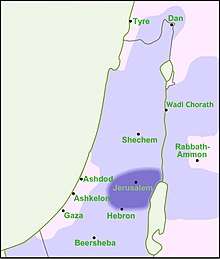Tishbe
Tishbe, sometimes transliterated as Thisbe,[1] is, according to tradition, identical to the historical town of Listib ("el-Ishtib" or "el-Istib" in Arabic),[2] the ruins of which are located 13 kilometers north of the Jabbok River (presently the Zarqa River) in the historical region Gilead referenced in Sacred Scripture, and just west of Mahanaim[3] and only a little beyond the northwest limits of Ajloun in the Ajloun Governorate in northern Jordan. Albeit debated by scholars, 1 Kings, 17: 1 indicates that Tishbe was the residence and possibly even birthplace of the Prophet Elijah (see Tishbite). However, the toponym may denominate another location, as discussed below.

Possible Locations
1 Kings, 17: 1 indicates that Elijah was from Tishbe in Gilead, which is a historical region located east of the Jordan River in present Jordan. The Jewish ancient historian Josephus supposed that Tishbe was in Gilead.[4] The eastern half of the Israelite Tribe of Manasseh and, possibly also, the Tribe of Gad, possessed Gilead; therefore Tishbe was probably in the territory of eastern Manasseh, but possibly in that of Gad instead. According to Pfieffer and Vos, it is located in the territory of Manasseh, on or proximate to the Wadi Chorath, in present day Jordan.[5] Tishbe is traditionally and usually identified as historical Listib in Gilead, as precisely located above. However, BiblePlaces.com indicates that there is evidence that historical Tishbe may have been located instead at either the site of "Umm el-Hedamus" or "Abu Hummus", proximate to Listib in the vicinity of Tell Mar Elias, or simply "Mar Elias", which is the location in Gilead of the ruins of Byzantine churches commemorating the life of Elijah.[6]
Alternatively, Tishbe may be identical to the as of yet undiscovered "Thisbe" referenced in Tobit, 1: 2, which was located west of the Jordan River in the territory of the Tribe of Naphtali, because Listib in historical Gilead east of the Jordan River is known to have been uninhabited during the time of the Northern Kingdom of Israel.[7]
References
- ↑ "An Exposition, with Practical Observations, of the First Book of Kings", Christian Classics Ethereal Library
- ↑ Biblical Training, "Tishbite",
- ↑ Biblical Training, "Tishbite",
- ↑ Ant., 8: 13, 2.
- ↑ Pfieffer and Vos, The Wycliffe Historical Geography of Bible Lands, Map 6 (Chicago, Illinois: Moody Press, 1967).
- ↑ BiblePlaces.com, "Upper Gilead", "Tishbe, Home of Elijah",
- ↑ Harrison, R. K., "Tishbite", in G. W. Bromiley, gen. ed., International Standard Bible Encyclopedia, Rev., Vol. 4, p. 861 (Grand Rapids, Michigan: Eerdmans, 1988).